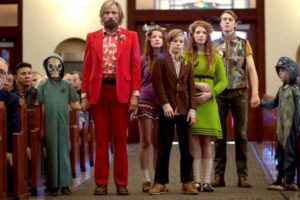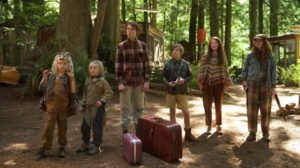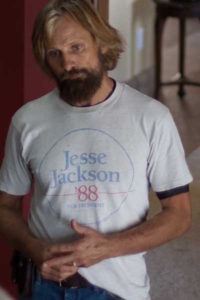 “Big Hollywood movies tell you what to think and feel. I did not want to do that with this film. I wanted a story that makes you question what you are doing and provokes many points of view with no clear heroes or villains,” said writer/director Matt Ross.
“Big Hollywood movies tell you what to think and feel. I did not want to do that with this film. I wanted a story that makes you question what you are doing and provokes many points of view with no clear heroes or villains,” said writer/director Matt Ross.
Captain Fantastic is the story of a devoted man raising his six children off-the-grid. When his wife dies, his ideas about how he is raising the kids are challenged both from within and without the family, which leads to a story that is both heart-wrenching and comic at the same time.
The film opens with a brutal, and almost barbaric, scene of a deer being hunted and killed as a rite of passage for the oldest son Bo (played by British actor George Mackay). Although one understands that to live off the land you must kill and eat game, the line in the credits that said “no animals were killed or harmed in the making of this film” was somewhat suspect. Ross explained that he wanted to make it clear from the beginning that this was not a road film comedy and he wanted it to be as real as possible. However, the deer scene was filmed with a trained deer named Leland, “who did not do one thing he was trained to do” said Ross, except when he laid down to die, which according to editor Joseph Krings, he did beautifully.
Krings, who also did the editing on Ross’s 28 Hotels Rooms, said that although making sure that everything looked real and worked on the set was of prime importance, they also took advantage of a time when the school bus got stuck in traffic on the freeway to ad-lib a scene where they projected images of the landscape along the highway on the windows to give the feeling that the bus was moving while Ben delivered his ad-lib speech.
Cinematographer Stéphane Fontaine, who has earned three César Awards for his work on Rust and Bone, A Prophet and The Beat That My Heart Skipped, shot Captain Fantastic using the Arri Alexa with Leica Summicron-C Lenses and Leica Summilux-C Lenses.
 Ross shared that there were two necessary skills that Fontaine brought to the table for this film. “We wanted to be able to follow the children in an organic way, but still make pretty pictures,” said Ross. “His films are cinematic masterpieces, in my opinion. He knows how to tell the story with his camera. I wanted to create an environment where we followed the actors, instead of just setting marks on the floor, so we needed someone with a real sensitivity to performance. Stéphane just threw the camera on his back and chased the children around the woods. That’s ultimately what was required to capture the performances we wanted in gorgeously lit pictures.”
Ross shared that there were two necessary skills that Fontaine brought to the table for this film. “We wanted to be able to follow the children in an organic way, but still make pretty pictures,” said Ross. “His films are cinematic masterpieces, in my opinion. He knows how to tell the story with his camera. I wanted to create an environment where we followed the actors, instead of just setting marks on the floor, so we needed someone with a real sensitivity to performance. Stéphane just threw the camera on his back and chased the children around the woods. That’s ultimately what was required to capture the performances we wanted in gorgeously lit pictures.”
Production designer Russell Barnes was tasked with building the Cash house and surroundings from the ground up and was instrumental in carrying forward the film’s mantra of keeping it real. “The conversation always revolved around making it real,” said Ross. “Russell came up with ideas that weren’t in the script, like having solar energy. He asked, where’s the running water source? What’s the sanitation like? How are you cooking? It became about solving those problems in a way that made sense.”
“First, I asked myself how a family of seven could live and work in this environment,” Barnes explained. “I had to figure out how much space they would need, how much water they required and all the other basic things. I roughed it out in my mind and once that was in place, I started working on the aesthetic. I amassed hundreds of different photos of off-the-grid and survivalist properties that were full of ingenious ways of living off the land.” From the tipi that shelters the family to the intricate pulley systems and platforms that transport them through the treetops, Barnes constructed a meticulously detailed, practical setting that has become a tourist destination because is it just that cool
He also had to design Steve, the Cash’s travel bus, which he did by adapting an old Bluebird school bus. The challenge here was that the school bus needed to be completely functional for the family to use on the road but still accommodate a film crew.
Casting director Jeanne MacCarthy, whose most recent work is on the TV series The Last Man On Earth, had her hands full with a worldwide talent search for young actors to play the six children ranging in age from seven to 18 years old. The actors had to be willing to take wilderness training survival school where they learned how to do such diverse things as martial arts, speak foreign languages like Esperanto, archery, rock climbing, and butchering a sheep, as well as well as being able to handle language and ideas well above their grade level.
“Matt created an atmosphere in which good things could happen,” said Viggo Mortensen when talking about some of the most difficult scenes including one where he tells the children bluntly that their mother died by committing suicide. The cast, headed by Mortensen as Ben do an amazing job of engaging the audience as Ben challenges, trains, and teaches the children to be a combination of “philosopher kings” and elite athletes. Having an environment which felt safe for them to experiment in resulted in a closeness and ease between actors that shows on the screen. The resulting conflicts between their extreme talents and their lack of real world experience bring moments of both pathos and humor to the film.
 Costume designer Courtney Hoffman enthused “We all relished every moment of this movie. Nothing could compare to the heart and soul of the film.” She went on to explain that she wanted to make sure that all the costumes reflected the type of environment that they were living in and what skills they were using to survive. “I tried to imagine what kinds of things Ben and Leslie would have taken when they first went into the forest and how that might influence the way their kids dress today,” she said. “The two older girls are at an age where they might be wearing Leslie’s clothes. The smaller kids wear hand-me-downs and remade things. There are some skins that they wear from their hunting. We wanted to incorporate a lot of handwork into it because they all know how to crochet, how to knit, how to darn. If they lost the buttons on a shirt or their jeans ripped, they wouldn’t throw them out, they’d fix them.”
Costume designer Courtney Hoffman enthused “We all relished every moment of this movie. Nothing could compare to the heart and soul of the film.” She went on to explain that she wanted to make sure that all the costumes reflected the type of environment that they were living in and what skills they were using to survive. “I tried to imagine what kinds of things Ben and Leslie would have taken when they first went into the forest and how that might influence the way their kids dress today,” she said. “The two older girls are at an age where they might be wearing Leslie’s clothes. The smaller kids wear hand-me-downs and remade things. There are some skins that they wear from their hunting. We wanted to incorporate a lot of handwork into it because they all know how to crochet, how to knit, how to darn. If they lost the buttons on a shirt or their jeans ripped, they wouldn’t throw them out, they’d fix them.”
Mortensen showed up with a truck full of items from his home that he thought would help to make the setting more realistic. Two of those items included a Jesse Jackson for President ’88 t-shirt and another piece that he added to the mix later: “I thought that he should wear whatever he wore to his wedding,” said Hoffman. “The next thing I knew, Viggo sent me a classic 1970s snap-front, red-patterned Western shirt, which he wore to his first wedding. I searched the entirety of the Internet for a cherry-red tuxedo to go with it!”
Threading through the film with what composer Alex Somers called “an earthy, understated sound” is a lovely soundtrack that fits well with what Ross conveyed to Somers that he was looking for, even though he said that he had a hard time explaining what that was. He was reassured when Somers told him, “Don’t worry. Even musicians have a hard time talking about music!”
Telling the story of Captain Fantastic has given Ross a chance to consider what he would do in Ben’s place. “That question is really the genesis of the movie,” the director said. “Ben has given up everything in order to raise his children this way. But by training them to survive in his world, he’s made them incapable of functioning in the real world. This movie is really about a man seeking balance. I hope it’s funny and sad, invites you to examine your own life and ideas, and is ultimately moving,”





